![]()
![]()
![]()
Use LEFT and RIGHT arrow keys to navigate between flashcards;
Use UP and DOWN arrow keys to flip the card;
H to show hint;
A reads text to speech;
28 Cards in this Set
- Front
- Back
- 3rd side (hint)
|
cell division process directly related to the embryonic growth?
|
mitosis
|
zygote divides itself giving birth to a series of cells that by mitosis also compose differentiated tissues and organs until the formation of a complete individual.
|
|
|
function of the vitellus in the egg?
|
Vitellus (yolk) is the nutritive material
|
|
|
|
How are these eggs classified according to the amount of vitellus within them?
|
According to the amount of vitellus in them, the vertebrate eggs are classified as oligolecithal (little yolk), centrolecithal, or heterolecithal (more yolk diffusely distributed) and telolecithal (more yolk concentrated in one end of the egg).
|
|
|
|
4. What are the four initial stages of the embryonic development?
|
morula stage,
blastula stage, gastrula stage neurula stage. |
|
|
|
cell division during the first stage of the embryonic development called? How is this stage characterized?
|
cleavage, or segmentation.
several mitoses occur the zygote forms a new embryo. |
|
|
|
cells produced in first stage of embryonic development called?
|
result from the cleavage
(the first stage of the embryonic development) are blastomeres. In this stage the embryo is called |
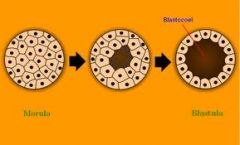
morula (similar to a “morus”, mulberry).
|
|
|
7. After the morula stage what is the next stage? What is the morphological feature that defines this stage?
|
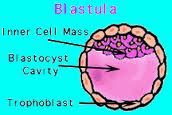
morula stage in which the embryo is a compact mass of cells,
next stage is the blastula blastula compactness is lost an internal cavity with fluid appears inside, the blastocele. |
|
|
|
Embryogeny
list teh first 9 stages |
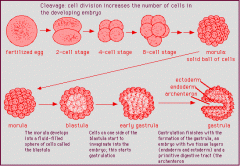
|
|
|
|
blastula stage what is the following stage of the embryonic development?
|
blastula turns into gastrula in
a process known as = |
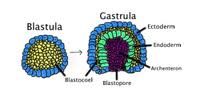
gastrulation
|
|
|
What is gastrulation?
during gastrulation how are the first two germ layers formed? What are these germ layers? |
blastula wall undergoes invagination inside the blastocele, forming a tube called archenteron (primitive intestine).
-Inner side of the tube form the endoderm (germ layer) -outer side form the ectoderm (another germ layer) info |
gastrulation
It is the beginning of the tissue differentiation in embryonic development. |
|
|
10. What are the archenteron and the blastopore? What is the stage of the embryonic development in which these structures are formed? What are the destinations of the archenteron and of the blastopore?
|
Archenteron is the tube ...
origin of gastrointestinal tract. Blastopore is the opening of the archenteron to the exterior. It is the origin of the gastrointestinal tract. Blastopore is the opening of the archenteron to the exterior. The blastopore gives birth to one of the extremities of the digestive tube: the mouth in protostome beings, or the anus in deuterostome beings. |
blastopore gives birth to one of the extremities of the digestive tube: the mouth in protostome beings, or the anus in deuterostome beings.
|
|
|
11. How is the mesoderm (third germ layer) of triploblastic animals formed?
|
The mesoderm appears from differentiation of endodermal cells that cover the dorsal region of the archenteron.
|
|
|
|
12. What are the three types of germ layers that form tissues and organs
|
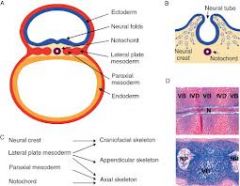
ectoderm,
mesoderm endoderm. |
|
|
|
How does the embryo turn from gastrula into neurula?
|
The neurula stage is characterized by the appearance of the neural tube along the dorsal region of the embryo.
|
|
|
|
How is the neural tube formed?
|
The growth of mesoderm in that region induces the differentiation of ectodermal cells just above. These cells then differentiate forming the neural tube.
|
|
|
|
What is the embryonic origin of the nervous system i
|
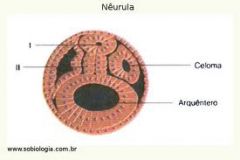
origin of the nervous system is the ectoderm
(the same germ layer that gives birth to the skin). |
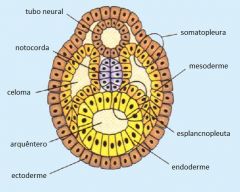
|
|
|
15. What is the notochord?
|
-notochord is a rodlike structure
-supporting axis of the embryo -gives birth to the vertebral column in vertebrates. How is this structure formed? |
|
|
|
20. What are somites?
|
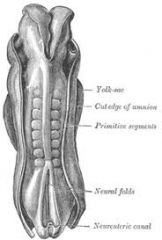
Somites are differentiated portions of mesodermal tissue longitudinally distributed along the embryo. The somites originate the muscle tissue and portions of the connective tissues.
|
|
|
|
21. What is organogenesis?
|
Organogenesis is the process of organ formation.
|
|
|
|
21. What is histogenesis
|
Histogenesis is the process of tissue formation in the embryonic development.
|
|
|
|
Before histogenesis and organogenesis the primitive embryonic structures have been already formed:
|
-germ layers,
-neural tube, -notochord, -coeloms, -somites. |
|
|
|
Epidermis and nervous system have the same embryonic origin:
|
ectoderm
|
|
|
|
epidermal appendages (like nails, hair, sweat glands and sebaceous glands), the mammary glands, the adenohypophysis, the cornea, the crystalline lens and the retina are derived from =
|
ectoderm
|
|
|
|
23. From which germ layer do blood cells originate?
|
Blood cells have a mesodermal embryonic origin.
|
|
|
|
What other organs and tissues are from mesodermal embryonic origin?
|
Other organs made from mesoderm are: covering serous membranes like :
-pericardium, -peritoneum -pleura, -muscles, -cartilages, -dermis, -adipose tissue, -kidneys, ureters, -bladder, urethra, -gonads, blood -lymph vessels, -bones. |
|
|
|
24. From which germ layer do the liver and the pancreas originate?
|
endoderm
What are other organs and tissues made from that germ layer? |
endodermal origin are the epithelia of the airway, the epithelia of the bladder, of the urethra and of the GI tube (except of the mouth and anus), the alveolar cells of the lungs and the thyroid and parathyroid glands.
|
|
|
25. What are twins? Genetically what are the two types of twins that can be generated?
|
Twins are simultaneously generated (within the mother’s uterus) offspring. Twins classify according to zygosity as monozygotic or as dizygotic twins.
Monozygotic twins, also known as identical twins, are those originated from one single fertilized ovum (therefore from one single zygote); monozygotic twins are genetically identical, i.e., they have identical genotypes and are necessarily of the same sex. Dizygotic twins, also known as fraternal twins, are those generated from two different ova fecundated by two different sperm cells; so they are not genetically identical and they are not necessarily of the same sex. |
|
|
|
26. What is polyembryony?
|

Polyembryony is the phenomenon in which a single embryo in its initial embryonic stage divides itself forming many new individuals of the same sex and genetically identical. This is the way, for example, in which reproduction takes place in armadillos of the genus Dasypus. Polyembryony is an example of natural “cloning”.
|
|

